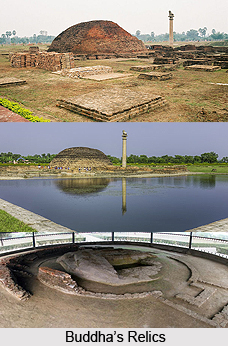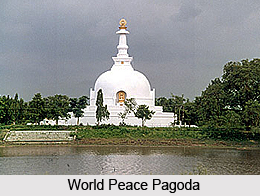 Vaishali is chiefly noted as one of the places where Gautama Buddha often preached. Numerous references to Vaishali are found in texts pertaining to both Jainism and Buddhism, which have preserved much information on Vaishali and the other Mahajanapadas. This place is considered one of the first examples of a republic, in the Vajjian Confederacy (Vajji) Mahajanapada, around the 6th century BC. It was here in 599 BC the 24th Jain Tirthankara; Lord Mahavira was born and brought up in Kundalagrama in Vaishali republic, which makes it a pious and auspicious pilgrimage to Jains community. It is supposed that the town derived its name from King Vishal. The king`s heroic deeds have been mentioned in the Hindu epic Ramayana. Vaishali was the capital city of the Licchavi tribe. However according to history, Pataliputra was the centre of political activity in the Gangetic plains and Vaishali came into existence as centre of the Ganga. It was the seat of the Republic of Vajji. Vaishali is credited with being the World`s First Republic to have a duly elected assembly of representatives and efficient administration.
Vaishali is chiefly noted as one of the places where Gautama Buddha often preached. Numerous references to Vaishali are found in texts pertaining to both Jainism and Buddhism, which have preserved much information on Vaishali and the other Mahajanapadas. This place is considered one of the first examples of a republic, in the Vajjian Confederacy (Vajji) Mahajanapada, around the 6th century BC. It was here in 599 BC the 24th Jain Tirthankara; Lord Mahavira was born and brought up in Kundalagrama in Vaishali republic, which makes it a pious and auspicious pilgrimage to Jains community. It is supposed that the town derived its name from King Vishal. The king`s heroic deeds have been mentioned in the Hindu epic Ramayana. Vaishali was the capital city of the Licchavi tribe. However according to history, Pataliputra was the centre of political activity in the Gangetic plains and Vaishali came into existence as centre of the Ganga. It was the seat of the Republic of Vajji. Vaishali is credited with being the World`s First Republic to have a duly elected assembly of representatives and efficient administration.
Lord Buddha"s last Varshavas (rainy season) was here and he announced his approaching Mahaparinirvana (the final departure from the world) just 3 months in advance. Before leaving for Kushinagar, where he laid his mortal coil, he left his alms-bowl here with the people of Vaishali. Vaishali is also renowned as the home of Ambapali, a great courtesan who appears in many folktales as well as in Buddhist literature. Ambapali became a disciple of Gautama Buddha.
Rulers of Vaishali
According to the Vishnu Purana records 34 Kings of Vaishali. The first king was believed to be Nabhaga, who renounced his throne over a matter of human rights and then declared himself as the free tiller of the soil, king over his own acre. The last among the 34 was Sumati, who is considered a contemporary of Dasharatha, father of the Hindu god, Rama.
Politics at Vaishali
 Vaishali consisted of 3 distinct portions viz. Vaishali, Kundagama and Vaniyagama. In the 6th century B.C. the Licchavis emerged as the most important political power. The earliest political fact about them is that they gave one of their daughters in marriage to Bimbisara of Magadha. They were also on friendly terms with the Kosala king Prasenjit and the Mallas. They were defeated by Ajatsatru.
Vaishali consisted of 3 distinct portions viz. Vaishali, Kundagama and Vaniyagama. In the 6th century B.C. the Licchavis emerged as the most important political power. The earliest political fact about them is that they gave one of their daughters in marriage to Bimbisara of Magadha. They were also on friendly terms with the Kosala king Prasenjit and the Mallas. They were defeated by Ajatsatru.
Relics at Vaishali
A kilometre away is Abhishek Pushkarini, the coronation tank. The sacred waters of the tank anointed the elected representatives of Vaishali. Next to it stands the Japanese temple and the Vishwa Shanti Stupa built by the Nipponzan-Myohoji-Daisanga sect, a Japanese new religion. A small number of Sarira found in Vaishali have been enshrined in the foundation and in the chhatra of this stupa. Near the coronation tank is Stupa 1 or the Relic Stupa. Here the Licchavis reverentially encased one of the 8 portions of Buddha`s relics, which they received after his Parinirvana. After his last discourse, Buddha set out for Kushinagar, but the Licchavis kept following him. Buddha gave them his alms bowl but they still refused to return. The Master created an illusion of a river in spate which compelled them to go back. This site can be identified with Deora in modern Kesaria, where Ashoka later built a Stupa.
Administration of Vaishali
The history of Vaishali is very important from the administrative point of view. It was an oligarchical republic. Citizenship was confined to the members of the united clans. The governmental authority in Vaishali was vested in a senate which consisted of the head of the resident Kshatriya clans and was presided over by a King assisted by a Viceroy and a Commander-in-Chief. Each citizen had the right to call himself a Raja, which was regarded as a synonym for Kshatriya. The Sanghas or corporations were united and hence unconquerable. The public hall was known as "Santhagar". They met there to hold religious and political discussions. There was an officer known as "Regulator of Seats". His duty was to see that the members sit in order of seniority. All matters were settled by majority vote. A quorum was fixed for the meeting. The Nayaka or the Chief Magistrate was elected by the people. He was an executive officer and carried out the decisions of the Assembly. The Vinischay-Mahamatta enquired and examined the accused and his duty was to ascertain the guilt.



















